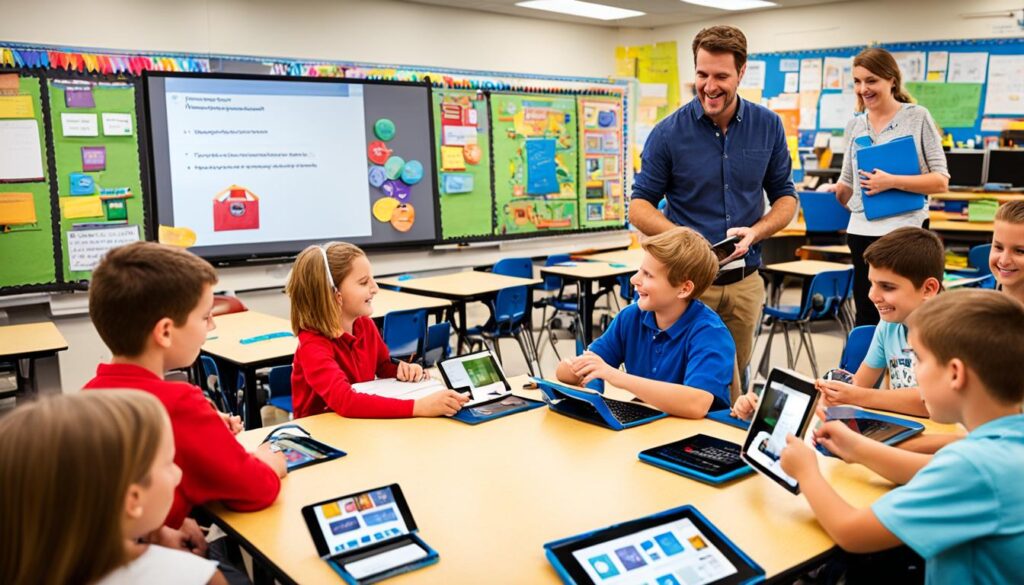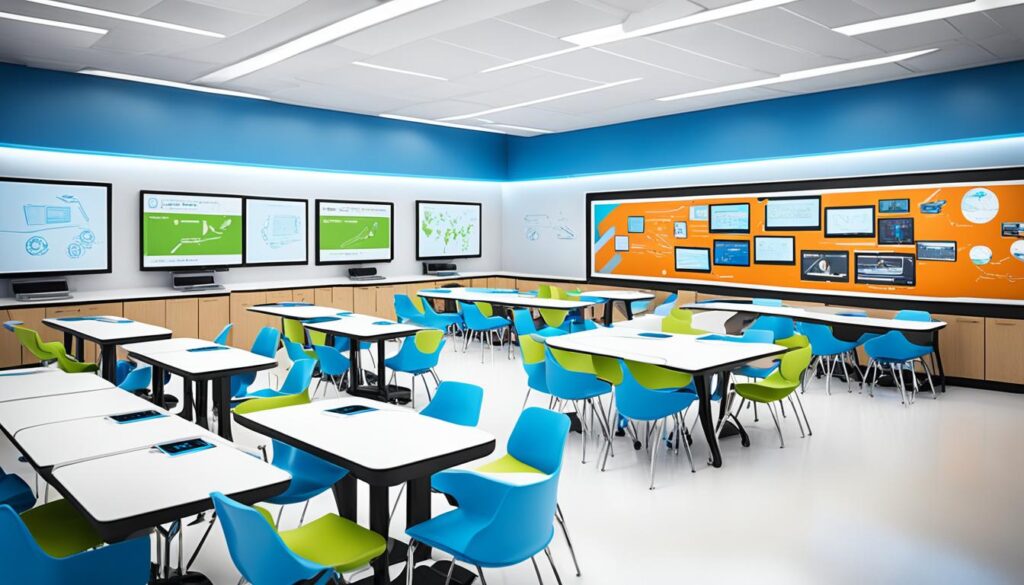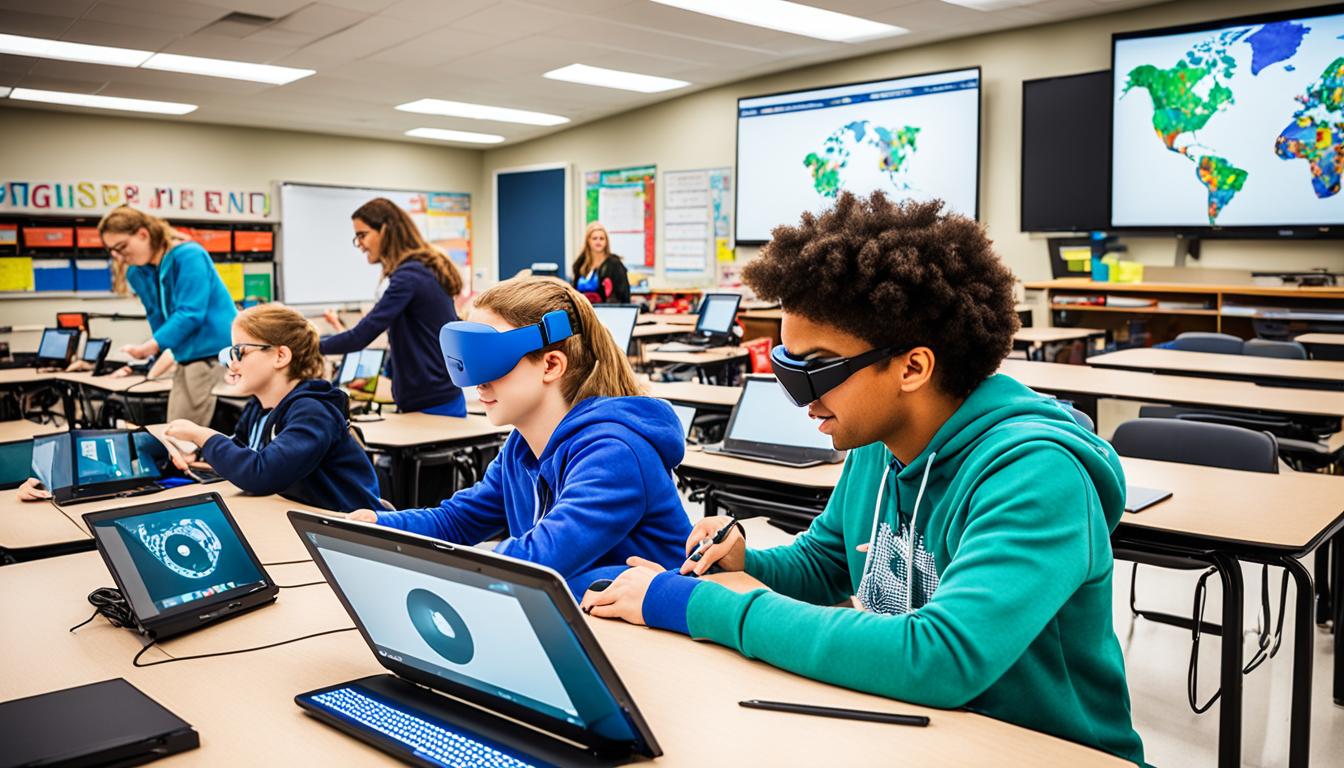Technology integration means using tech tools in classrooms and school tasks. It’s about smoothly blending technology into learning goals and improving how we teach. Done well, technology feels like an essential, natural part of learning for everyone involved.
Key Takeaways:
- Technology integration involves the use of technology resources in classrooms and schools.
- It supports curricular goals and enhances classroom practices.
- When integrated seamlessly, technology becomes a natural part of the learning process.
- Technology integration benefits both students and teachers.
- Effective technology integration requires accessibility and support.
Importance of Technology Integration in Education
Technology integration in education boosts learning and classroom efficiency. It creates a dynamic space for students and teachers. They can get the latest info, work together, and share their ideas through media.
Teachers make lessons more fun and interactive with technology. This helps students explore, research, and show what they’ve learned in cool ways. It makes their learning better and gets them ready for the digital future.
Adding technology to teaching tools lets educators spice up lessons with interactive books, online labs, and apps. They can adjust their teaching to fit different learning styles AKA make lessons rock.
Also, tech makes teaching better by cutting down on boring tasks and helping everyone communicate. Things like online grades and classroom apps help share info faster and easier.
Enhancing Learning Through Technology Integration
Tech in education boosts how well students learn by:
- Boosting learning by giving access to tons of info, not just from books.
- Getting students into lessons with cool, interactive stuff, making them want to join in.
- Helping them solve real problems, learning digital and thinking skills.
- Making them work together online, do projects, and learn from afar.
Improving Productivity and Daily Classroom Practices
Tech also makes daily class life better by:
- Doing boring jobs automatically, so teachers have more time for fun learning.
- Letting teachers meet each student’s unique needs and style.
- Giving instant test feedback and helping students when they need it most.
- Bringing everyone closer with emails, online class tools, and video meetings.
| Benefits of Technology Integration in Education | Enhance Learning | Improve Productivity |
|---|---|---|
| Access to up-to-date information and diverse educational resources | *Enhanced engagement through interactive and multimedia-rich content | *Automation of administrative tasks, saving time and effort |
| Opportunities for collaboration and teamwork | *Encourages critical thinking and problem-solving skills | *Supports differentiated instruction for individualized learning |
| Preparation for the digital world and future career opportunities | *Promotes formative and summative assessments for effective feedback | *Streamlines communication and collaboration among stakeholders |
Ways to Integrate Technology in the Classroom
Using technology in the classroom can change how students learn and engage. There are many ways to use tech to help students learn and take part more. Let’s look at some good methods for this:
1. Whole-Class Instruction with Power Points
Teaching the whole class with technology can really grab student’s attention. Many teachers use Power Points for this. These presentations include images and video. They can make hard topics easier to get.
2. Utilizing Educational Apps
Educational apps cover various topics and offer fun ways to learn. They may have quizzes or simulations that match what students are studying. Using these apps makes learning more fun and meets various learning needs.
3. Internet Homework Assignments
Homework that uses the internet teaches students to learn on their own. They can use the web to research, find e-books, work in groups, and hand in work online. This helps students take charge of their learning and improve their tech skills.
4. Online Grading Systems for Communication
Online grading helps teachers, students, and parents talk better. Teachers can send feedback quickly and keep track of how students are doing. They can also share school events with parents easily. This makes for a better learning team.
5. Classroom Tablets for Differentiation
Tablets in the classroom let each student learn in their way. They can use digital books, apps, and other tools made just for them. Tablets also help students work together on projects. This builds their teamwork and thinking skills.
6. Utilizing Listserv for Parent-Teacher Communication
Listserv makes it easy for parents and teachers to stay in touch. Teachers can update parents easily. It also lets parents ask questions. This strengthens the team working for the student’s success.
Using these methods, teachers can bring technology into the classroom in a smart way. This helps in learning actively, working together, and getting ready for a tech-filled future.
Strategies for Implementing Technology in Different Age Groups
Integrating technology in the classroom needs special strategies for different ages. This approach helps meet the needs of each group. It makes learning a lot more engaging. Let’s check out how to use tech in schools for each age.
Elementary Classroom
Technology is a key tool in elementary classrooms. It helps in learning basic skills. Things like fun educational apps and easy websites can catch kids’ interest. This includes Prodigy for math and Starfall for reading.
For hands-on work, teachers can use tablets with special apps. Apps like Kodable boost critical thinking and creativity. They make learning more fun.
In elementary schools, interactive whiteboards are also awesome. They let teachers make lessons that kids can join in. This makes learning about teamwork, critical thinking, and how to communicate.
Middle School Classroom
Technology is crucial in middle school for basic life skills. It gets students ready for harder academic work. Middle schoolers learn to research online. They use digital libraries and databases to find reliable information.
Using tech for group projects and presentations is great. Sites like Padlet and Edmodo help students work together. They can share ideas with their classmates and teachers.
For better teaching, middle schools can use tools like Socrative. These tools help teachers see if their students are getting the lesson. They can then adjust the lesson as needed right away.
High School Classroom
In high school, technology is key for future success. Tools like Microsoft Office and Google Drive help with team projects and managing documents. This prepares students for their next steps after high school.
Teaching coding and programming languages improves tech and problem-solving skills. Sites like Code.org and Scratch make learning fun. They offer interactive coding lessons.
For studying, high schools can use sites like Quizlet. It has flashcards and games that make reviewing fun.
Teachers can blend technology into lessons across all school grades. It’s about meeting the learning needs of every student. Tailored tech use boosts learning and teamwork and makes the classroom exciting.
Benefits of Technology Integration in the Classroom
Using technology in class makes learning more fun and effective. It offers many advantages for students.
Catering to Different Learning Styles
Tech helps teachers meet the needs of all kinds of learners. Visual learners, for example, love videos and pictures. Audio learners do well with discussions and listens. Those who like to move can use hands-on projects and games.
Enhancing Student Engagement
Technology makes learning interactive, drawing students in. Virtual tours and fun educational games are perfect examples. It gets students excited and helps them learn actively.
| Benefits of Technology Integration in the Classroom |
|---|
| Enhanced student engagement |
| Catering to different learning styles |
| Development of important life skills |
| Preparation for the digital world |
Development of Important Life Skills
Tech helps students gain skills that are key today. This includes being good with technology, problem-solving, teamwork, and communication. They learn these by actually using tech for learning.
Preparation for the Digital World
Learning with technology gets students ready for our digital world. Knowing how to use digital tools is really important now. Tech in class lets students practice these skills in a safe space.
Overall, using technology in class has many good points. It helps students learn in ways that suit them. It makes learning more interesting and helps students grow important skills for life. Plus, it prepares them for the tech-driven future. Embracing tech helps teachers make a learning space where every student can succeed.

Overcoming Obstacles in Technology Integration
Bringing tech into classrooms is great, but it has some problems. Some think using tech costs too much. Yet, students don’t need to own tech to enjoy its education benefits.
Using tech well needs good habits and watching. Set up clear rules for tech and keep an eye on its use. This helps keep students on track with their learning and not getting off course.
Not having enough tech and help is another issue. Yet, we can find solutions by being creative and working together. Educators can ask for more resources from their school. They can also partner with local companies to get help with tech. Sharing with other teachers can also make resources go further.
Tackling these problems helps tech be a big plus in education. It allows students to get the most from using tech.
Models for Technology Integration
Instructional leaders have models and frameworks for using technology in the classroom. Among them, the SAMR model and the TPACK framework are popular. They help teachers effectively use technology with students.
The SAMR model shows how to transform teaching using technology. It has four levels. These range from just swapping out traditional tasks to completely new ways of learning. The goal is to go beyond simple tech use. Instead, use it to change and improve how students learn.

The TPACK framework looks at how Technological, Pedagogical, and Content Knowledge meet. It says teachers need to deeply understand teaching, what they are teaching, and how to use tech. When these three areas work together, teachers can create amazing learning experiences. These can boost student interest and learning.
Both models help leaders and teachers make tech really work in the classroom. They guide the growth of important knowledge and skills. With these tools, educators can help their students learn better using technology.
Comparison of the SAMR Model and the TPACK Framework
| SAMR Model | TPACK Framework |
|---|---|
| Focuses on the transformation of teaching and learning through technology | Emphasizes the intersection of technological, pedagogical, and content knowledge |
| Provides a roadmap for integrating technology at different levels of complexity | Guides educators in developing the necessary knowledge and skills for effective technology integration |
| Promotes the redefinition of tasks through technology | Encourages thoughtful and purposeful integration of technology into instructional practices |
Impact of Technology Integration on Learning Outcomes
Technology in education greatly improves how students learn. It makes learning more interesting and interactive. Students get more involved, think more critically, and work together better.
Thanks to technology, learning is not only in books anymore. Students use digital tools to find and understand information. This makes learning more dynamic and fits different student needs.
Technology lets teachers teach in a way that’s right for each student. They can use special software and online tools to help everyone learn at their own speed. This way, teachers make sure each student gets the help they need.
Student Engagement
Technology makes learning fun and interesting. Students get to watch videos, play games, and do simulations. This keeps them interested and helps them learn better. Teachers can connect school lessons to real life using technology.
Critical Thinking and Collaboration
Technology helps students think critically. They can look up information online. They learn to tell what sources are trustworthy and form their own opinions. At the same time, students learn to work as a team on the internet.
Technology integration allows for personalized and differentiated instruction, leading to improved learning outcomes.
Using technology teaches students skills they can use all the time. They get used to using digital tools and learn to talk online respectfully. These skills are super important today.
Overall, technology improves how much students learn, how well they do, and how they work with others. With the right tech, all students can do their best. It prepares them for school and the digital world.
Challenges and Future Trends in Technology Integration
Technology integration offers many benefits. But, there are challenges to overcome. One big issue is access to technology. This hits students from poorer families hard. The digital divide talks about this gap. It’s important we work to make sure everyone has fair access to tech. This helps to keep education equal for all.
Teachers also face challenges in using technology. Many feel unsure or not skilled enough. We must offer them continuous support. This will help teachers use tech to its full benefit in the classroom.
In the future, tech will do even more. Artificial intelligence (AI) will change how students learn. It will personalize learning to fit each student. On top of that, virtual reality (VR) will bring new ways of learning. It might turn learning into something students do, not just something they study.
Tech will learn how students like to learn. Then, it will help students learn at their own speed. This will make sure students get the help they need to learn hard topics.
The Digital Divide: Ensuring Equity in Access to Technology
Not everyone can access the same technology. The digital divide creates a gap in who gets to use tech. This can lead to unequal chances in school. We must make sure all students can get the tech they need. This includes things like good internet and devices at home and school.
We also must think about the cost of tech. Some families can’t buy what’s needed. Schools can help by offering to loan or subsidize tech. This is important to make sure all students have the resources they need.
It’s up to everyone to work together on this. Let’s partner with groups and companies. Together, we can make sure every student has what they need to learn with tech.
Professional Development: Empowering Educators for Effective Technology Integration
For tech to work well in schools, teachers need support and training. Many teachers struggle with how to use tech effectively. We should give them ongoing help. This will boost their skill and confidence in using tech for teaching.
Training for teachers should focus on practical knowledge. This includes how to pick the best tech tools. And how to use them to make learning more fun and effective. By doing this, teachers can use tech in ways that really help their students.
Future Trends in Technology Integration
Tech is going to change school for the better. For example, AI can help students learn in ways that suit them best. It can also give instant feedback to make learning more engaging.
VR is also coming to schools. It will let students visit new places or try out new experiences. This makes learning hands-on and exciting.
But there’s even more. Tech that changes based on each student’s needs is also on the way. It will help students learn harder subjects and do better in school.

| Challenges | Future Trends |
|---|---|
| Access to technology | Artificial intelligence (AI) |
| Bridge the digital divide | Virtual reality (VR) |
| Professional development | Adaptive learning technologies |
| Equitable access | |
| Support for educators |
Research on Technology Integration and its Effects
Studies show that using technology in classrooms can benefit students a lot. It makes them more interested in learning and working together. They also improve their thinking and solving skills.
At Stanford University, a study proved that tech boosts student grades. Those who used technology in their studies got 12% higher scores. This is compared to students who didn’t use tech. Using technology can help students learn in ways that make sense to them.
Another study, in the Journal of Educational Psychology, looked at how tech affects student interest. They found that tech made students 25% more involved in their studies. This extra interest made them want to learn more and be part of class activities.
Tech also gets students ready for jobs in the future. The International Society for Technology in Education (ISTE) found that students with tech are better at using digital tools. This makes them more ready for work where they have to use technology a lot.
But, using tech well needs teachers who know how to use it. The National Education Association (NEA) thinks teachers should get trained in tech. When teachers know how to use tech, they feel more sure and can teach students better with technology.
To sum up, using technology helps students learn more and do better at school. It makes learning fun and useful. With the right help, teachers can use technology to make studying a great experience for students. This way, students get ready for a bright future in the modern world.
Conclusion
Technology is vital in education, bringing many advantages for both students and teachers. It boosts learning, keeps students interested, and helps them learn important digital skills.
But, there are some challenges like unequal access to technology and needing enough support and resources. Despite these issues, the benefits of using technology in education are huge. Studies show that it improves how well students do, how engaged they are, and their critical thinking.
To prepare for the future, teachers need to keep an eye on new tech trends and change their teaching methods when needed. Things like artificial intelligence, virtual reality, and adaptive tech are key to education’s future. By staying updated and open to these new technologies, teachers can create an environment where students flourish in the digital era.
FAQ
What is technology integration?
Technology integration means using tech in everyday classroom and school activities. It’s about using technology easily and openly. This should help meet teaching goals.
Why is technology integration important in education?
It’s key because it makes learning better and more productive. It gives students and teachers the latest info. Everyone can work together better and share ideas using tech.
What are some ways to integrate technology in the classroom?
In the classroom, use technology for teaching with things like power points. Assign online homework. Grade online to connect with students. Give tablets for different works. Use Listserv to talk to parents.
How can technology be implemented in different age groups?
Elementary schools can use tech for basic skills. In middle schools, tech helps learn life skills like research. High schools use tech to get ready for further studies and jobs.
What are the benefits of technology integration in the classroom?
Using tech keeps students interested and helps them learn in different ways. It also teaches them important skills for life. Plus, it gets them ready for the tech-filled world we live in.
What are some obstacles to technology integration?
Some see it as too expensive. Others say they don’t have enough support or tools. But, people can work together to find solutions.
What are the commonly used models for technology integration?
The SAMR model and the TPACK framework are popular. They both help teachers and students use tech more effectively.
What is the impact of technology integration on learning outcomes?
It boosts student grades, makes them more active in learning, and improves critical thinking. Tech also lets teachers adjust lessons to suit each student, which helps everyone learn better.
What are the challenges and future trends in technology integration?
Some find it hard to get everyone the tech they need. But, we hope to see more AI, VR, and tech that learns along with students.
What does research say about technology integration?
Research points to better student motivation and skills with tech. It makes them more ready for a tech-driven future.


















